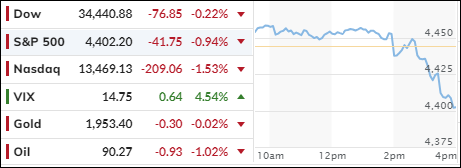
- Moving the markets
The Fed meeting was the main event of the day, as everyone waited with bated breath to see what the central bank would do with interest rates. Would they hike, cut, or hold steady? Would they signal a dovish or hawkish stance? Would they make any jokes or puns to lighten the mood? Spoiler alert: they did none of the above.
Instead, the Fed delivered a mixed bag of messages that left the markets confused and disappointed. They kept rates unchanged, as expected, but hinted at one more hike before the year ends.
They also said they would start cutting rates next year, but not as much as they previously indicated. They raised their growth and inflation forecasts but lowered their unemployment projections. They said they would be careful and flexible, but also vigilant and proactive.
In other words, the Fed tried to have their cake and eat it too. But the markets were not amused. They wanted a clear and consistent direction from the Fed, not a wishy-washy and contradictory one. They wanted a Fed that was either done or ready to cut, not one that was still hiking while preparing to cut. They wanted a Fed that was either fighting inflation or supporting growth, not one that was doing both at the same time.
So, what did the markets do? They threw a tantrum. The major indexes plunged into the close, with the S&P barely clinging to its 4,400 level. Bond yields spiked, with the 2-year hitting a new high since 2006. The most shorted stocks tanked, as investors lost their appetite for risk. The dollar went on a roller coaster ride, which reversed gold’s early gains.
The only winners of the day were the oil prices, which eased slightly after reaching $92 on Tuesday. But that was hardly a consolation prize for the markets, which feared that higher energy prices would fuel inflation and slow down the economy.
The bottom line is that uncertainty reigned today, as the Fed failed to deliver a clear and coherent message to the markets.
The question now is: Will the Fed change its tune in the next meeting, or will it continue to confuse and disappoint?
2. “Buy” Cycle Suggestions
The current Buy cycle began on 12/1/2022, and I gave you some ETF tips based on my StatSheet back then. But if you joined me later, you might want to check out the latest StatSheet, which I update and post every Thursday at 6:30 pm PST.
You should also think about how much risk you can handle when picking your ETFs. If you are more cautious, you might want to go for the ones in the middle of the M-Index rankings. And if you don’t want to go all in, you can start with a 33% exposure and see how it goes.
We are in a crazy time, with the economy going downhill and some earnings taking a hit. That will eventually drag down stock prices too. So, in my advisor’s practice, we are looking for some value, growth and dividend ETFs that can weather the storm. And of course, gold is always a good friend.
Whatever you invest in, don’t forget to use a trailing sell stop of 8-12% to protect yourself from big losses.
3. Trend Tracking Indexes (TTIs)
As was not expected, the Fed meeting ended with a hawkish outlook for next year, which triggered a sell-off as investors feared fewer rate cuts.
This also affected our Domestic TTI, which fell slightly below its long-term trend line. This signals a possible shift from a bullish to a bearish market. However, I will wait for more evidence of this trend before ending the current “Buy” cycle.
This is how we closed 09/20/2023:
Domestic TTI: -0.20% below its M/A (prior close +0.26%)—Buy signal effective 12/1/2022.
International TTI: +3.20% above its M/A (prior close +3.51%)—Buy signal effective 12/1/2022.
All linked charts above are courtesy of Bloomberg via ZeroHedge.
Contact Ulli